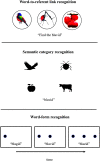Direct Instruction Improves Word Learning for Children With Developmental Language Disorder
- PMID: 36342854
- PMCID: PMC9940895
- DOI: 10.1044/2022_JSLHR-22-00300
Direct Instruction Improves Word Learning for Children With Developmental Language Disorder
Abstract
Purpose: The current study compared the effects of direct instruction versus indirect exposure on multiple aspects of novel word learning for children with developmental language disorder (DLD) and children with typical language development (TLD).
Method: Participants included 36 children with DLD and 45 children with TLD. All children were in the first grade and 6-8 years of age (Mdn = 7 years; 2 months). Using a between-subjects design, children were randomly assigned to be exposed to novel words and their unfamiliar referents via either direct instruction (each referent presented in isolation with an explicit goal of learning) or indirect exposure (multiple referents presented with the goal of answering yes/no questions).
Results: In alternative forced-choice measures of recognition, children with DLD were less accurate than their TLD peers in linking words to referents, encoding semantic categories for words, and encoding detailed representations of word forms. These differences in word learning were accounted for by a constellation of cognitive measures, including receptive vocabulary, phonological memory, visuospatial memory, and sustained attention. All children were similarly accurate in retaining word forms over a 24- to 48-hr delay. Children with TLD were more accurate in all aspects of word learning following direct instruction compared to indirect exposure. Benefits from direct instruction were observed for children with DLD in link and semantic, but not word form, learning.
Conclusions: These results suggest that vocabulary interventions with direct instruction can help children with DLD learn some, but not all, aspects of novel words. Additional support is necessary to help children with DLD encode rich phonological representations.
Figures
Similar articles
-
The Fast-Mapping Abilities of Adults With Developmental Language Disorder.J Speech Lang Hear Res. 2020 Sep 15;63(9):3117-3129. doi: 10.1044/2020_JSLHR-19-00418. Epub 2020 Aug 13. J Speech Lang Hear Res. 2020. PMID: 32787708 Free PMC article.
-
Spoken Word Learning in Children With Developmental Language Disorder or Dyslexia.J Speech Lang Hear Res. 2021 Jul 16;64(7):2734-2749. doi: 10.1044/2021_JSLHR-20-00217. Epub 2021 Jun 28. J Speech Lang Hear Res. 2021. PMID: 34185581 Free PMC article.
-
Word Learning in Arabic Diglossia in Children With Typical Language Development and Developmental Language Disorder.J Speech Lang Hear Res. 2025 Mar 26;68(3S):1533-1551. doi: 10.1044/2024_JSLHR-23-00618. Epub 2024 Oct 7. J Speech Lang Hear Res. 2025. PMID: 39378264
-
The evaluation of word-learning abilities in people with developmental language disorder: a scoping review.Int J Lang Commun Disord. 2019 Sep;54(5):742-755. doi: 10.1111/1460-6984.12490. Epub 2019 Jul 5. Int J Lang Commun Disord. 2019. PMID: 31276299
-
Vocabulary interventions for children with developmental language disorder: a systematic review.Front Psychol. 2025 Mar 19;16:1517311. doi: 10.3389/fpsyg.2025.1517311. eCollection 2025. Front Psychol. 2025. PMID: 40177040 Free PMC article.
Cited by
-
Word learning by children with developmental language disorder: Identifying gaps in our understanding of spaced retrieval effects.Autism Dev Lang Impair. 2024 Aug 30;9:23969415241275940. doi: 10.1177/23969415241275940. eCollection 2024 Jan-Dec. Autism Dev Lang Impair. 2024. PMID: 39221431 Free PMC article.
References
-
- Alloway, T. P. (2007). Automated Working Memory Assessment. Pearson Assessment.
-
- Beck, I. L. , McKeown, M. G. , & Kucan, L. (2013). Bringing words to life: Robust vocabulary instruction (2nd ed.). Guilford.
-
- Biemiller, A. , & Slonim, N. (2001). Estimating root word vocabulary growth in normative and advantaged populations: Evidence for a common sequence of vocabulary acquisition. Journal of Educational Psychology, 93(3), 498–520. https://doi.org/10.1037/0022-0663.93.3.498
-
- Bishop, D. V. M. , & Hsu, H. J. (2015). The declarative system in children with specific language impairment: A comparison of meaningful and meaningless auditory-visual paired associate learning. BMC Psychology, 3(1), 3. https://doi.org/10.1186/s40359-015-0062-7 - PMC - PubMed
-
- Brosseau-Lapré, F. , Schumaker, J. , & Kluender, K. R. (2020). Perception of medial consonants by children with and without speech and language disorders: A preliminary study. American Journal of Speech-Language Pathology, 29(2), 883–889. https://doi.org/10.1044/2020_AJSLP-19-00062 - PMC - PubMed
Publication types
MeSH terms
Grants and funding
LinkOut - more resources
Full Text Sources
Miscellaneous




